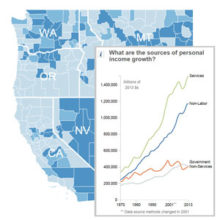While the U.S. West is well-known for its scenic vistas and national parks—think Grand Canyon, Zion, or Yellowstone—it also is one of the most urbanized regions of the country.
The share of people living in metropolitan areas in the West (89%) is higher than in the rest of the country–where, on average, 75 percent of people live in metropolitan areas. In terms of the proportion of people in metro areas, the West is as urban as the Northeast (89%), and more urban than the Midwest (70%) and South (73%).
Coincident with the distribution of people, most western jobs also are concentrated in urban areas. Urban areas drive economic growth in the West, and these interactive maps show how employment is concentrated in metro counties for each western state.
It’s not surprising that cities still drive economic activity. As Harvard economist Edward Glaeser points out in his book,
The Triumph of the City:
“For over a century pundits have been predicting that new forms of communication would make urban life irrelevant… [Technology was] supposed to eliminate the need for face-to-face meetings, yet business travel has soared over the last twenty years. To defeat the human need for face-to-face contacts, our technological marvels would need to defeat millions of years of human evolution that has made us into machines for learning from the people next to us.”
Access to cities is critical for economic development, and ideally access means the ability to get there personally via road or air travel.
Given the importance of cities, the West’s concentration of people and economic activity in comparatively few locations presents an advantage. Continued growth in the Wests’ cities results in opportunities for a larger percent of the population.
In fact, 95 percent of westerners reside in either Metropolitan or “Connected” counties, those connected to metropolitan areas via airports with daily commercial services. (Learn more about the Three Wests and its distinct types of counties—Metro, Connected, and Isolated—defined by their access to major markets and population centers by either road or air travel.)
“Connected” counties are poised for economic development, particularly with continued investment in transportation links, both highways and airports, which allow businesses to expand into new areas.
However, less than five percent of the western population is spread across the nearly 50 percent of western lands in counties classified as “Isolated.” From these counties, it is difficult to get to major population centers via road or air travel.
“Isolated” counties face real challenges in terms of economic opportunity and access to social services, such as hospitals and schools. These counties are characterized by slower population growth, lower education and skill levels, lower job earnings, and more volatile income levels.
Some “Isolated” counties in the West may be able to enhance their connection with Metro areas by expanding and improving transportation links; but, extending fast data lines may be a more immediate way to spur economic development.
While modern technology may never be a panacea for isolated places, internet access has been proven to increase access to jobs, educational resources, health care information, and even government services.
Overall, across both the connected and isolated West, economic well-being and quality of life can be improved by investing in both transportation and communications infrastructure.




